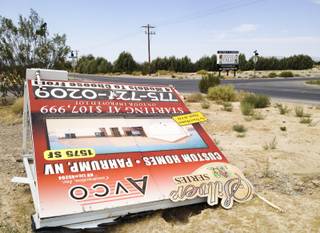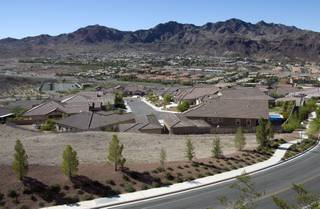Pahrump real estate broker Norma Jean Opatik didn’t have to network or advertise during Southern Nevada’s real estate boom. As long as her office was open, clients flooded in.
Builders, investors and others flocked to the rural town, 50 miles west of Las Vegas, to snatch up property. People lined up in Opatik’s office to pay hyper-inflated prices for homes in a town with legal brothels, a strong gun culture and no major industries. Prices were cheaper than in Las Vegas, and buyers figured they could commute.
A similar rush took place in other cities on the outskirts of Las Vegas. Real estate boomed in Boulder City, Mesquite and Laughlin as investors, retirees and others moved in.
The housing bubble, of course, eventually burst. And like in Las Vegas, real estate in the rural areas crashed.
Small, rural housing markets are prone to extreme highs and lows, Home Builders Research President Dennis Smith said, and the ones near Las Vegas are no exception. The towns rely heavily on leisure and tourism to feed the economy, as many residents have low-paying casino service jobs.
“When the discretionary income dried up, the towns dried up,” Smith said.
Now as the economy rebounds, property values are climbing in Pahrump, Boulder City, Laughlin and Mesquite. But the rise isn’t as pronounced as in Las Vegas, and unlike in the valley, construction is largely at a standstill.
Las Vegas’ recovery has been fueled in large part by out-of-state investors buying rental properties in bulk. In the valley, the market has heated up so much and so fast that some experts worry another bubble is forming. That’s not a concern in the rural areas, where investors are scarce.
“It’s a great time to be buying, but (people are) just not here to buy,” said broker Tom Patton, owner of Laughlin Properties.
Mesquite
Mesquite sits 85 miles northeast of Las Vegas. The small resort community on the Arizona border draws snowbirds and retirees.
Like Las Vegas, it experienced a real estate boom last decade.
Mesquite’s median home value peaked at $250,300 in 2006, up from $99,500 in 1997. In July, the median value was $171,600, down 31 percent from the high but up 18 percent over the past year, according to Zillow.
Construction also rose at a stunning pace.
In 2005, builders pulled 599 permits for single-family homes, more than double the 289 permits pulled in 2002.
“You couldn’t build them fast enough,” real estate agent Leroy “Buck” Schaeffel said.
From 2000 to 2010, the city’s population soared 63 percent to 15,276, according to U.S. Census Bureau data. Many newcomers were lured by the city’s warm weather, casinos and golf courses.
Home listings dwindled to almost nothing because of demand. When Schaeffel moved to Mesquite in 2005, there were only 13 previously owned single-family homes for sale.
The market took a big hit when the bubble burst, but things are improving.
A total of 287 single-family homes sold last year at an average price of $193,000. The same number of homes sold this year by mid-September at an average price of $225,500, Schaeffel said.
Housing developments also are under construction. The largest is Sun City Mesquite, but developer Del Webb is far from finished.
Executives plan to build 3,800 homes there but have completed fewer than 950 so far, Schaeffel said.
Laughlin
Laughlin, an unincorporated town with a string of casinos on the Colorado River, didn’t experience a housing boom last decade, but its neighbor Bullhead City, Ariz., did.
With almost no industry besides resorts, Laughlin’s population rose just 3.5 percent last decade to 7,323. Across the river in Bullhead City, where many of the casino workers live, the population climbed 17 percent to 39,540.
Construction in Bullhead City, however, has ground to a halt. In 2005, builders pulled 925 permits for single-family homes. Last year, they pulled 36, city records show. The population since 2010 has been flat.
In Laughlin, the only subdivisions that appear to be under construction are in Bilbray Ranch, a master-planned community. Not much is being built there, though.
Las Vegas-based Harmony Homes has sold 18 homes in Bilbray Ranch this year, up from 16 in 2012, President Robb Beville said.
Beville said he expanded south because he saw Laughlin as a low-risk investment. He builds homes only after they sell.
And business is better than anticipated, he said. Going in, Beville expected to sell only six houses a year.
“It’s not like Laughlin’s economy is booming,” Beville said.
Boulder City
Boulder City is a 15-minute drive from the valley but seems a world away. Gambling is banned, and city officials impose strict building restrictions.
Just 120 permits a year can be issued for commercial housing construction, and no developer can build more than 30 homes annually.
What’s more, the city owns most of the vacant land in town, and officials need voter approval to sell anything more than an acre. Locals say that’s unlikely to happen since they want to protect their community’s small-town atmosphere.
“We don’t have to allow the growth,” said broker Cokie Booth, owner of BC Real Estate.
Because of the hurdles, builders tend to avoid the city. Its population rose less than 1 percent from 2000 to 2010 and hovers around 15,000.
City Hall issues five to 10 permits a year to commercial developers and another three to six permits to people who want to build their own homes, said Brok Armantrout, Boulder City’s director of community development.
“We really haven’t had anyone approach us,” Armantrout said of big builders.
The only large project started in recent years was the 47-home Tuscany Retreat. Developer Randy Schams bought the site from a private seller rather than the city.
Construction began several years ago but stalled during the recession. The project only recently was completed.
Despite the dearth of new projects, property values skyrocketed in Boulder City during the flush years.
Boulder City’s median home value rose from $135,900 in 1996 to a peak of $351,800 in 2006, according to Zillow. It was $207,800 in July, down 41 percent from 2006 but up 20 percent from last summer.
Strict development laws crimp the supply of homes for sale, keeping prices higher but making it difficult for many buyers to find affordable homes. This month, only 74 houses were for sale city-wide, Booth said.
Booth sells homes in the valley as well to stay afloat.
“I could not stay alive just in Boulder City,” she said.
Pahrump
A few miles west of Highway 160 in Pahrump, Beazer Homes cleared land for a Las Vegas-style subdivision of modern houses. The project, Burson Ranch, got government approval in 2005, and developers were set to build 586 single-family homes.
But the economy had other plans.
Today, the site appears abandoned. Just a few dozen homes sit among large swaths of vacant land, and the roads are unpaved and laced with weeds. Near the main entrance, a Beazer sign and fence are knocked over.
Pahrump’s real estate boom and bust mirrored Las Vegas’ more closely than other rural Southern Nevada communities, in large part because of projects such as Burson.
An unincorporated town in Nye County with strong libertarian leanings, Pahrump for years had practically no building restrictions. People built where and what they wanted. Offices, retail centers, medical buildings and casinos are sprinkled along the town’s main corridor with little sense of organization.
When Las Vegas real estate started booming, Pahrump was seen as a cheaper alternative, a far-flung suburb from which people could commute to the big city. Prices soared as investors from around the world bought homes, and subdivisions sprouted frequently.
In June 2004, The Wall Street Journal ran a front-page story calling Pahrump the second-fastest growing “micropolis” in the country.
“We’re under a huge building boom,” a Nye County planning official said in 2003. “Quite frankly, it’s frightening because we have no standards.”
Nye County commissioners approved at least nine housing developments in Pahrump from 2002-08, allowing more than 17,000 homes to be built.
Real estate agents, overwhelmed with clients, sold houses every day. Homes that today would list for $150,000 sold for $500,000.
“It was insane,” said Opatik, owner of Realty Executives.
From 2000-10, Pahrump’s population grew 48 percent to 36,441.
But Pahrump’s real estate market imploded after the economy crashed. Real estate there flatlined six to 12 months after it did in Las Vegas.
Many new projects, including Burson Ranch, got mothballed. Builders left town.
Today, only one subdivision is under construction. William Lyon Homes is building 14 houses in the Mountain Falls master-planned community.
Pahrump’s foreclosure rate is higher than both the state’s and other outlying towns’. About 0.19 percent of homeowners in Pahrump received a foreclosure-related filing in July, compared with 0.09 percent in Laughlin, 0.11 percent in Boulder City, 0.12 percent in Mesquite and 0.14 percent statewide, according to RealtyTrac. Many residents have abandoned their homes.
Still, the market is slowly turning. Opatik’s group sold about 40 homes last month, far more than in August 2012. Pahrump also has seen an influx of investors looking for deals after the housing market crashed, although rebounding prices now are causing them to taper back.
Additionally, Beazer officials recently visited Mountain Falls on a scouting trip. William Lyon sales agent Debbie Davis said they told her they were looking to restart construction at Burson Ranch.
William Lyon agents try to sell a house a week at Mountain Falls. Buyers include retirees, people who work from home and those who don’t mind commuting to Las Vegas.
“They’ve made this a lifestyle choice,” William Lyon Nevada Division President Mary Connelly said.
Source: Zillow. Produced by Kyle B. Hansen


